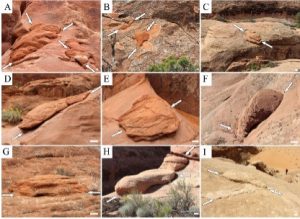 The article presents a new look on sandstone weathering/recession characterized by rapid disintegration of portions of the rock massif which are no longer physically connected with the main rock mass, though still in situ. A set of field and laboratory measurements testing mechanical and hydraulic properties of the rock were applied to compare the disconnected portions with those of the surrounding rock mass. Also, physical weathering experiments were performed to characterize the effect of confinement on the breakdown rate of several sandstone samples. The surfaces of disconnection follow bedding planes, planar elements of other sedimentary structures, subhorizontal fractures and stress shadows on subvertical cliff faces. Weathered surfaces of the disconnected portions show noticeably impaired mechanical properties, a faster capillary water absorption and a higher surface moisture compared to the much less weathered surfaces of the surrounding rock mass. Physical experiments demonstrated that a confinement by the surrounding rock mass may considerably delay the loosening of rock during weathering. The much faster disintegration rates of the disconnected portions of rock compared to their surroundings are explained by the fact that they are not confined and have a larger surface area.The recession rates of sandstone surfaces with disconnected portions are highly variable both in space and time and their genesis is demonstrated by two suggested conceptual models.
The article presents a new look on sandstone weathering/recession characterized by rapid disintegration of portions of the rock massif which are no longer physically connected with the main rock mass, though still in situ. A set of field and laboratory measurements testing mechanical and hydraulic properties of the rock were applied to compare the disconnected portions with those of the surrounding rock mass. Also, physical weathering experiments were performed to characterize the effect of confinement on the breakdown rate of several sandstone samples. The surfaces of disconnection follow bedding planes, planar elements of other sedimentary structures, subhorizontal fractures and stress shadows on subvertical cliff faces. Weathered surfaces of the disconnected portions show noticeably impaired mechanical properties, a faster capillary water absorption and a higher surface moisture compared to the much less weathered surfaces of the surrounding rock mass. Physical experiments demonstrated that a confinement by the surrounding rock mass may considerably delay the loosening of rock during weathering. The much faster disintegration rates of the disconnected portions of rock compared to their surroundings are explained by the fact that they are not confined and have a larger surface area.The recession rates of sandstone surfaces with disconnected portions are highly variable both in space and time and their genesis is demonstrated by two suggested conceptual models.
Filippi M., Slavík M., Bruthans J., Weiss T., Řihošek J. (2021): Accelerated disintegration of in situ disconnected portions of sandstone outcrops. Geomorphology 391, 107897. (DOI)








